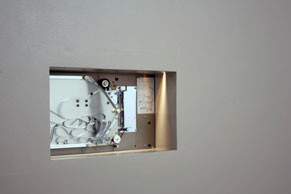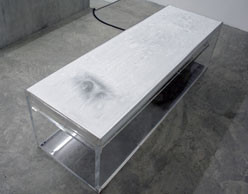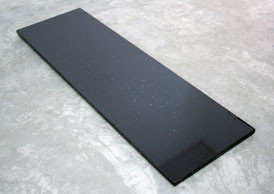Vergänglichkeit
16 Mar - 28 Apr 2007

© Alexander Gutke: ‘The White Light Of The Void’, 2002, 16 mm film installation (installation view at galerie schleicher+lange)

© Laurent Montaron, courtesy galerie schleicher+lange, Paris
'Melancholia', 2004, modified Roland RE-201 Space-echo
'Melancholia', 2004, modified Roland RE-201 Space-echo

© Mel O'Callaghan, courtesy galerie schleicher+lange, Paris
‘All In One Day’, 2007, water, motor, refridgeration system, plexi-glass, steel, timer, 180 x 60 x 55 cm
‘All In One Day’, 2007, water, motor, refridgeration system, plexi-glass, steel, timer, 180 x 60 x 55 cm
VERGÄNGLICHKEIT
Galerie schleicher+lange is pleased to announce the group exhibition, Vergänglichkeit, bringing together the works of five artists based around the concept of transience and the different aspects of time; ephemeral, eternal and repetitive.
Tinnitus by Laurent Montaron (*1972, France) is a tone inscribed upon the surface of a vinyl record that gradually destructs itself over time. Each time in use, the sound, imitating the medical phenomenon of ‘tinnitus’, is further altered; thus creating a form of auto-destruction that over time puts an end to the unpleasant ‘ringing’ that is left in one’s ear.
In the photographic work 9 ways to say it’s over by Alexander Gutke (*1971, Sweden), the notion of transience, in opposition to the eternal, exists in relation to its foreseen end. Nine film stills, taken from various black and white films from 1920 to 1960, announce ‘The End’ in a variety of languages. The linguistic diversity of these signs tells us something about the universal perceptions of romance, loss and the finality of life. The filmic usage of ‘The End’, however obvious it may seem today, played a huge role in defining how our experience had come to an end. The film arrives at its final narrative destination while the psychological space created between the viewer, the characters and the story continues to live a life of its own.
Gutke’s installation The white light of the void simulates the deterioration of a seemingly empty 16mm film that gathers dusts and scratches until it gets jammed and due to the heat of the projector’s lamp gradually melts away. The narrative is stripped down to the bare essentials of film; light and the wear and tear that the film material is exposed to. When the film burns out, the loop is completed and we find ourselves back at the beginning with an empty film running towards its eventual meltdown. Although presenting what we know to be an inherent aspect of the cinematic medium, the deterioration has in fact been created artificially with digital software. Because of the films fragility and the exposed nature of the loop system, real deterioration soon starts to mix with the fictional representation, as the recurrent enactment of a fictional end leads eventually to the films real destruction.
Death and the vanity of life are also part of Sonja Engelhardt’s work Birthmarks: The smooth surface of a plate of granite is broken up by small alterations that are based on the birthmarks of the artist’s own body. The black plate bears a strong resemblance to gravestones in that the durability of their materiality allows for a short existence to be eternalized. For the artist, (*1975, Germany) the birthmarks and their constellation on the plate’s surface formally also recall a starlit night sky, touching on references to the universe and the question of eternity.
Pernille Kapper Williams (*1973, Denmark) equally eternalizes an ephemeral event in her most recent work Homage to Bas Jan Ader (PLEASE DON’T LEAVE ME), a tribute to the Dutch conceptual artist who disappeared in 1975. Referring to his famous work Please don’t leave me (1969, installation, painted writing on the wall), Pernille Kapper Williams uses the same quotation but this time writes the words with her finger tips on a steam covered mirror: once the steam has vanished, the writing becomes invisible. By losing the original purpose of reflecting an image, the object acquires another function: to reveal a hidden message which content is in itself an appeal for survival and longevity. The spectator thus enters into a dialogue with the work in which his own image and the writing that defines the work cannot co-exist.
If one considers that nothing disappears and nothing gets created ex-nihilo, but rather everything is just a permanent transformation, like an event that has no focal point in the continuity of time, such as a length of time of an extended temporary movement, Transience in this sense is linked to the eternal through the repetition of a cyclic movement.
Made especially for this occasion, Mel O’Callaghan (*1975, Australia) presents All in one day, a sculptural installation consisting of a shallow container filled with an uncertain body of water that constantly changes its consistency: the water gradually freezes so that it moves from a liquid state to a solid one and vice-versa. In constant flux the water becomes ice and melts again in an eternal circle, a progress that is similar to certain ideas that surround the creation and destruction of the universe, an idea that one finds also evident in Gutke’s, The White Light of the Void and Laurent Montaron’s, Melancholia which is a soundless space-echo built into a wall that is realised both graphically and schematically this temporality.
Galerie schleicher+lange is pleased to announce the group exhibition, Vergänglichkeit, bringing together the works of five artists based around the concept of transience and the different aspects of time; ephemeral, eternal and repetitive.
Tinnitus by Laurent Montaron (*1972, France) is a tone inscribed upon the surface of a vinyl record that gradually destructs itself over time. Each time in use, the sound, imitating the medical phenomenon of ‘tinnitus’, is further altered; thus creating a form of auto-destruction that over time puts an end to the unpleasant ‘ringing’ that is left in one’s ear.
In the photographic work 9 ways to say it’s over by Alexander Gutke (*1971, Sweden), the notion of transience, in opposition to the eternal, exists in relation to its foreseen end. Nine film stills, taken from various black and white films from 1920 to 1960, announce ‘The End’ in a variety of languages. The linguistic diversity of these signs tells us something about the universal perceptions of romance, loss and the finality of life. The filmic usage of ‘The End’, however obvious it may seem today, played a huge role in defining how our experience had come to an end. The film arrives at its final narrative destination while the psychological space created between the viewer, the characters and the story continues to live a life of its own.
Gutke’s installation The white light of the void simulates the deterioration of a seemingly empty 16mm film that gathers dusts and scratches until it gets jammed and due to the heat of the projector’s lamp gradually melts away. The narrative is stripped down to the bare essentials of film; light and the wear and tear that the film material is exposed to. When the film burns out, the loop is completed and we find ourselves back at the beginning with an empty film running towards its eventual meltdown. Although presenting what we know to be an inherent aspect of the cinematic medium, the deterioration has in fact been created artificially with digital software. Because of the films fragility and the exposed nature of the loop system, real deterioration soon starts to mix with the fictional representation, as the recurrent enactment of a fictional end leads eventually to the films real destruction.
Death and the vanity of life are also part of Sonja Engelhardt’s work Birthmarks: The smooth surface of a plate of granite is broken up by small alterations that are based on the birthmarks of the artist’s own body. The black plate bears a strong resemblance to gravestones in that the durability of their materiality allows for a short existence to be eternalized. For the artist, (*1975, Germany) the birthmarks and their constellation on the plate’s surface formally also recall a starlit night sky, touching on references to the universe and the question of eternity.
Pernille Kapper Williams (*1973, Denmark) equally eternalizes an ephemeral event in her most recent work Homage to Bas Jan Ader (PLEASE DON’T LEAVE ME), a tribute to the Dutch conceptual artist who disappeared in 1975. Referring to his famous work Please don’t leave me (1969, installation, painted writing on the wall), Pernille Kapper Williams uses the same quotation but this time writes the words with her finger tips on a steam covered mirror: once the steam has vanished, the writing becomes invisible. By losing the original purpose of reflecting an image, the object acquires another function: to reveal a hidden message which content is in itself an appeal for survival and longevity. The spectator thus enters into a dialogue with the work in which his own image and the writing that defines the work cannot co-exist.
If one considers that nothing disappears and nothing gets created ex-nihilo, but rather everything is just a permanent transformation, like an event that has no focal point in the continuity of time, such as a length of time of an extended temporary movement, Transience in this sense is linked to the eternal through the repetition of a cyclic movement.
Made especially for this occasion, Mel O’Callaghan (*1975, Australia) presents All in one day, a sculptural installation consisting of a shallow container filled with an uncertain body of water that constantly changes its consistency: the water gradually freezes so that it moves from a liquid state to a solid one and vice-versa. In constant flux the water becomes ice and melts again in an eternal circle, a progress that is similar to certain ideas that surround the creation and destruction of the universe, an idea that one finds also evident in Gutke’s, The White Light of the Void and Laurent Montaron’s, Melancholia which is a soundless space-echo built into a wall that is realised both graphically and schematically this temporality.

